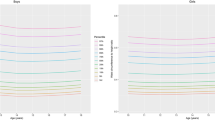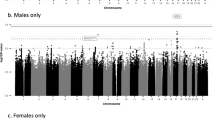Abstract
Background:
The ratio of the lengths of the 2nd and 4th digit (2D:4D) is negatively related to prenatal and adult concentrations of testosterone (T). Testosterone appears to be a protective against myocardial infarction (MI) in men as men with low 2D:4D are older at first MI than men with high 2D:4D, and men with coronary artery disease have lower T levels than men with normal angiograms. Neck circumference (NC), a simple and time-saving screening measure to identify obesity is reported to be positively correlated with the factors of the metabolic syndrome, a complex breakdown of normal physiology characterized by obesity, insulin resistance, hyperlipidemia, and hypertension, and is therefore likely to increase the risk of coronary heart disease (CHD).
Objective:
To investigate possible associations between 2D:4D ratios and NC in men and women.
Research methods and procedures:
2D:4D ratios, NC, along with measures of waist and hip circumferences, body mass index (BMI), and waist-to-hip ratio was recorded from 127 men and 117 women.
Results:
A significant positive correlation between 2D:4D and NC and was found for men but not for women after controlling for body mass index (BMI); the higher the ratio the higher the NC.
Discussion:
This finding supports the suggestion of NC to serve as a predictor for increased risk for CHD as previously suggested. In addition, the present association suggests a predisposition for men towards CHD via 2D:4D as proxy to early sex-steroid exposure.
This is a preview of subscription content, access via your institution
Access options
Subscribe to this journal
Receive 12 print issues and online access
$259.00 per year
only $21.58 per issue
Buy this article
- Purchase on Springer Link
- Instant access to full article PDF
Prices may be subject to local taxes which are calculated during checkout
Similar content being viewed by others
References
Phelps VR . Relative index finger length as a sex-influenced trait in man. Am J Hum Genet 1952; 4: 72–89.
Manning JT, Scutt D, Wilson J, Lewis-Jones DI . The ratio of 2nd to 4th digit length: a predictor of sperm numbers and concentrations of testosterone, luteinizing hormone and oestrogen. Hum Reprod 1998; 3: 3000–3004.
Manning JT . Digit Ratio: A Pointer to Fertility, Behaviour and Health. New Jersey: Rutgers University Press, 2002.
Manning JT, Wood S, Vang E, Walton J, Bundred PE, van Heyningen C et al. Second to fourth digit ratio (2D:4D) and testosterone in men. Asian J Androl 2004; 6: 211–215.
Garn SM, Burdi AR, Babler WJ . Early prenatal attainment of adult metacarpal-phalangeal rankings and proportions. Am J Phys Anthropol 1975; 43: 327–332.
Manning JT, Barley L, Lewis-Jones I, Walton J, Trivers RL, Thornhill R et al. The 2nd to 4th digit ratio, sexual dimorphism, population differences and reproductive success: evidence for sexually antagonistic genes. Evol Hum Behav 2000; 21: 163–183.
Peters M, Tan U, Kang Y, Teixeria L, Mandal M . Sex-specific finger-length patterns linked to behavioral variables across human populations. Percept Mot Skills 2002; 94: 171–181.
Lutchmaya S, Baron-Cohen S, Raggatt P, Knickmeyer R, Manning JT . 2nd to 4th digit ratios, fetal testosterone and estradiol. Early Hum Dev 2004; 77: 23–28.
Manning JT, Trivers RL, Singh D, Thornhill R . The mystery of female beauty. Nature 1999; 399: 214–215.
Singh D . Ideal female body shape: role of body weight and waist-to-hip ratio. Int J of Eat Disord 1994; 16: 283–288.
Abbott DH, Dumesic DA, Franks S . Developmental origin of polycystic ovary syndrome – a hypothesis. J Endocrinol 2002; 174: 1–5.
Rebuffe-Scrive M, Marin P, Bjorntrop P . Effect of testosterone on abdominal adipose tissue in men. Int J Obes 1991; 15: 791–795.
Vermeulen A, Goemaere S, Kaufman JM . Testosterone, body composition and aging. J Endocrinol Invest 1999; 22: 110–116.
Manning JT, Bundred PE . The ratio of 2nd to 4th digit length and age at first myocardial infarction in men: a link with testosterone? Br J Cardiol 2001; 8: 720–723.
Manning JT, Taylor R, Bundred PE . The ratio of 2nd and 4th digit length: a prenatal correlate of ability in sport. In: Reilly T, Marfell-Jones M (eds.) Kinanthropometry VIII. Routledge: London, 2003.
English KM, Mandour O, Steeds RP, Diver MJ, Jones TH, Channer KS . Men with coronary artery disease have lower levels of androgens than men with normal coronary angiograms. Eur Heart J 2000; 21: 890–894.
Cruz ML, Goran MI . The metabolic syndrome in children and adolescents. Curr Diab Rep 2004; 4: 53–62.
Ben-Noun L, Sohar E, Laor A . Neck circumference as a simple screening measure for identifying overweight and obese patients. Obes Res 2001; 9: 470–477.
Ben-Noun L, Laor A . Relationship of neck circumference to cardiovascular risk factors. Obes Res 2003; 11: 226–231.
Ben-Noun L, Laor A . Relationship between changes in neck circumference and changes in blood pressure. Am J Hypertens 2004; 17: 409–414.
Fink B, Neave N, Manning JT . Second to Fourth Digit Ratio, Body Mass Index, Waist-to-Hip Ratio, and Waist-to-Chest Ratio: their Relationships in Heterosexual Men and Women. Ann Hum Biol 2003; 30: 728–738.
Lippa RA . Are 2D:4D finger-length ratios related to sexual orientation? Yes for men, no for women. J Pers Soc Psychol 2003; 85: 179–188.
Siervogel RM, Demerath EW, Schubert C, Remsberg KE, Chumlea WC, Sun S et al. Puberty and body composition. Horm Res 2003; 60 (Suppl 1): 36–45.
Esmaillzadeh A, Mirmiran P, Azizi F . Waist-to-hip ratio is a better screening measure for cardiovascular risk factors than other anthropometric indicators in Tehranian adult men. Int J Obes Relat Metab Disord 2004; 28: 1325–1332.
Dalton M, Cameron AJ, Zimmet PZ, Shaw JE, Jolley D, AusDiab Steering Committee et al. Waist circumference, waist-hip ratio and body mass index and their correlation with cardiovascular disease risk factors in Australian adults. J Intern Med 2003; 254: 555–563.
Author information
Authors and Affiliations
Corresponding author
Rights and permissions
About this article
Cite this article
Fink, B., Manning, J. & Neave, N. The 2nd–4th digit ratio (2D:4D) and neck circumference: implications for risk factors in coronary heart disease. Int J Obes 30, 711–714 (2006). https://doi.org/10.1038/sj.ijo.0803154
Received:
Revised:
Accepted:
Published:
Issue Date:
DOI: https://doi.org/10.1038/sj.ijo.0803154
Keywords
This article is cited by
-
The 2D:4D index is associated with the development of excess body weight in adults, but not with the rate of weight loss following bariatric surgery
Scientific Reports (2022)
-
Low digit ratio (2D:4D) in male suicide victims
Journal of Neural Transmission (2016)
-
Neck circumference is not associated with dysphagia but with undernutrition in elderly individuals requiring long-term care
The Journal of nutrition, health and aging (2016)
-
Genetic association suggests that SMOC1 mediates between prenatal sex hormones and digit ratio
Human Genetics (2013)



